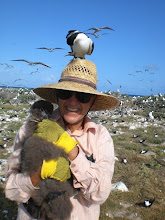

Several weeks ago Megan, my housemate, lost a water bottle on a snorkel trip out to the reef. She assumed someone had put it in their bag and not recognized it as belonging to another person. Almost 2 weeks later I found it washed up on the beach on Spit Island. It had probably fallen overboard on our trip and washed down the atoll and beached on Spit Island. It was a neat find. A week ago Wednesday on our way to Eastern Island for an early morning Duck Survey I had my hat blow off in the breeze from the moving boat and we didn't find it again. On Thursday this week, 8 days later, I was on another boat trip and when we returned my hat was floating against the seawall where we docked the boat. The current in the atoll is across the direction that my hat traveled and it managed to float through the narrow entrance to the inner harbor. Attached are pictures of the returned items.


































